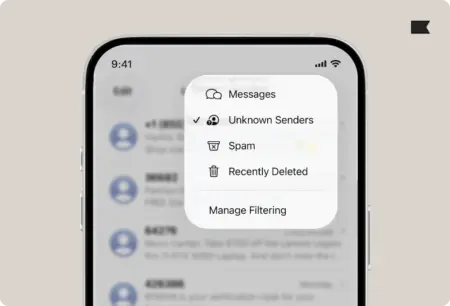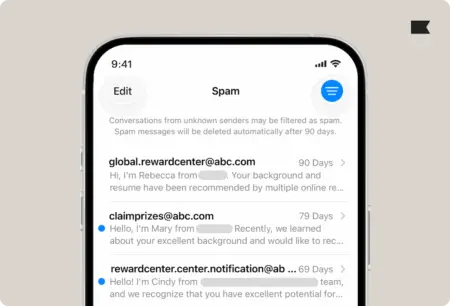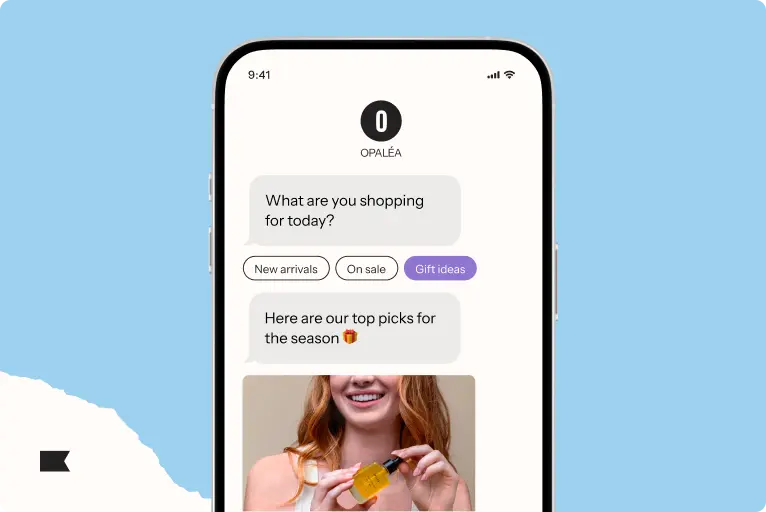iOS 26 and the future of text marketing: your complete guide to adapting and thriving

DISCLAIMER: iOS 26 updates are ongoing through launch in mid-September, so be sure to check back here for changes as Apple makes them.
Apple’s iOS 26 update is here. And it’s more than a software refresh. It’s a critical shift in how marketers need to think about mobile messaging.
While your text messages will still deliver, how (and whether) customers see them is changing fast. And so are expectations for how you show up in their inbox.
At Klaviyo, we believe the future belongs to brands that earn trust early, personalize messaging with real data, and build customer experiences that feel intentional—not interruptive. This update makes that future arrive faster.
That’s why Klaviyo is committed to building products that adapt so quickly as the industry evolves—so brands can stay ahead, instead of scrambling to catch up.
In this guide, we’ll walk through:
- What’s changing in iOS 26—and why it matters
- Who’s most affected and how
- What action marketers need to take
- Strategic guidance from Klaviyo
- Frequently asked questions and quick wins
What is iOS 26 and what is changing?
iOS 26 is part of Apple’s continued push toward subscribers’ privacy and message quality. It will change how subscribers see mobile messages—and how brands deliver and measure their impact. For marketers, that means rethinking how to earn visibility and prove value as their subscribers’ experiences on mobile devices evolve.
The update introduces 5 key changes with implications for SMS visibility, attribution, and consumer expectations. Let’s look at each.
1. Inbox filtering for unknown senders
Apple will give users the option to route messages from unsaved numbers to a separate “Unknown Senders” tab. It’s important to keep in mind that this isn’t enabled automatically, but individuals still have the ability to toggle this on and off. These messages still deliver, but if someone has turned on filtering they’re easier to miss—especially for newer subscribers who haven’t saved your number yet.

The marketing implication: Visibility—not deliverability—is the potential challenges. If your number isn’t saved, your message may get buried.
Sharing your contact card is a great best practice to apply here.
The most effective brands won’t leave a shopper saving your number to chance—they’ll design messaging to make saving or recognizing a number feel like a natural next step.
Another reliable method to avoid the “Unknown Senders” inbox is to use tap-to-text as your primary opt-in method. When a subscriber initiates the first message to your brand, Apple automatically treats your thread as a Known Sender—even if the subscriber hasn’t saved your number.
Learn how to collect SMS consent with tap-to-text.
2. SMS spam folder
Apple has also introduced a new spam folder for SMS to help filter out potentially malicious messages, like phishing attempts sent from email addresses. This filter is also optional and designed to catch suspicious or unverified texts.

Anthony Hornung, RCS product manager at Klaviyo, emphasizes the significance of using a branded sender ID (SID) or dedicated short codes.
Using a branded SID is more important than ever.
“Subscribers who recognize a brand name are far more likely to mark a number as known than they would a message from a random sender,“ says Hornung.
When a message is routed to spam, links are disabled and replies are blocked. However, users can still recover those messages to move them out of the spam folder.
The marketing implication: This has minimal to no impact for brands using verified sending methods. In the long run, it could actually boost trust by keeping inboxes cleaner and making real brand messages easier to recognize.
3. Smarter messages via Apple Intelligence
AI-driven features like message summaries and smart replies are becoming the new baseline. These tools reward clarity, relevance, and personalized value. Spray-and-pray SMS is officially over.
The marketing implication: Apple is training your customers to expect intelligent, human-centric communication. But this is already a popular consumer expectation. To deliver, marketers need a unified platform across channels––which is why Klaviyo built the CRM for B2C.
4. Broader support RCS messaging
With iOS 26, Apple continues its slow but steady rollout of RCS (Rich Communication Services)—text messages that look and act more like mini websites, with images, buttons, and branded layouts.
The marketing implication: SMS isn’t going away, but rich messaging is rising. RCS brings richer and more interactive messaging built for today’s shopper. It gives marketers a new way to drive action, especially for product launches, promotions, and high-intent flows.
Klaviyo is partnering with Google to shape the future of RCS. Join our beta waitlist to explore new use cases and stay on the cutting edge of mobile messaging.
“RCS has transformed mobile messaging, replacing plain text with rich and interactive experiences that drive engagement,” says Hornung. “With messages sent from verified sender IDs that show the brand’s name and logo, people will immediately recognize who it’s from and are far more likely to interact.”
RCS has transformed mobile messaging, replacing plain text with rich and interactive experiences that drive engagement.
5. Stricter link tracking protection
Since iOS 17, Apple has expanded link tracking protection across their Messages and Mail apps. This update targets known tracking identifiers—like ad platform click IDs (e.g., gclid, fbclid, msclkid)—used for retargeting and fingerprinting.
The marketing implication: First-party data and branded links are more important than ever for maintaining visibility into performance.
Learn how to create branded short links in Klaviyo.
Frequently asked questions
Q: What is RCS and can I use it now?
A: RCS (Rich Communication Services) is an enhanced messaging format that supports visuals, interactive buttons, and better branding. Apple started rolling it out with iOS 18. Klaviyo is currently offering RCS to select brands through our private beta program.
Q: Is Apple blocking SMS messages now?
A: Largely no. While the SMS spam folder does place malicious texts into a different folder, texts from brands are unlikely to be impacted by Spam. The “Unknown Senders” filtering is about visibility, not blocking. Messages from unsaved numbers simply appear in a separate tab that subscribers can check whenever they want. Remember consumers still have to enable “Unknown Senders” filtering because it isn’t turned on automatically.
Q: Should I be worried about SMS no longer working?
A: Not at all. SMS continues to drive strong ROI when it’s targeted, personalized, and well-timed. The key is integrating SMS into a broader omnichannel strategy rather than treating it as a standalone channel.
Q: How can I improve message visibility under iOS 26?
A: The most effective approach is to have new subscribers message you first when opting in via tap-to-text. This makes your brand a Known Sender from the start, keeping your texts in the main inbox. Follow that with a downloadable contact card in your welcome flow to make saving your number even easier.
iOS 26 pro tip: Subscribers can also “mark as known” any texts from your brand, if they don’t want to save your contact card.
Q: Will Apple remove UTM parameters?
A: No. Apple’s protections remove certain tracking identifiers (like gclid and fbclid), but not UTMs. Your campaign parameters will still work for attribution. However, expect less consistency in click ID–based reporting and use branded links wherever possible.
Q: How should I adjust my SMS strategy for iOS 26?
A: Focus on 5 key areas:
- Inbox placement: Drive Known Sender status with tap-to-text.
- Trust building: Get numbers saved early through contact cards.
- Personalization: Use behavioral data to send relevant, timely messages.
- Orchestration: Coordinate SMS with email, push, and other channels.
- Attribution: Adjust expectations and use branded links for clearer tracking.

Q: Which types of messages work best with the new changes?
A: Here’s our recommended channel mix by use case, though not an exhaustive list:
| Use case | Best channels | Why |
| Tap-to-text form | Mobile site | Helps keep your messages out of the “Unknown” tab |
| Welcome flow | SMS + email | Builds trust early, improves long term engagement |
| Cart abandonment | SMS + email | Combines urgency with detailed content |
| Product launches | SMS, push, + email | High visual impact, broad coverage |
| Loyalty offers | SMS + push | Quick delivery of personalized value |
| Transactional updates | SMS + email | Universal reach, instant delivery |
Q: How do I prepare for RCS?
A: Start by identifying high-impact use cases where visuals and interactivity matter most—product drops, back-in-stock alerts, and promotional campaigns are ideal candidates. If you’re interested in testing RCS, join our beta program.
Q: What should I do right now?
A: Here are the immediate actions to take:
This week:
- Use tap-to-text for SMS opt-in, especially for mobile browsers.
- Add a “save this number” step to your SMS opt-in flow.
- Include downloadable contact cards in welcome messages.
- Review your current SMS segmentation strategy.
This month:
- Test cross-channel coordination (SMS + email sequences).
- Monitor engagement by region to spot delivery changes.
- Prepare visually rich, conversational campaigns for RCS testing.
Ongoing:
- Use behavior-based triggers to meet shoppers where they are in the customer journey.
- Track branded link performance across devices.
- Refine personalization based on first-party data.
Ready to future-proof your SMS strategy?
iOS 26 marks the beginning of a more sophisticated, trust-based approach. The brands that thrive will be those who embrace personalization, earn subscriber trust, and create seamless experiences across all touchpoints.
As mobile messaging continues to change, we’ll keep moving fast to equip you with the tools, insights, and innovation you need to thrive.
Klaviyo’s unified CRM makes it easy to coordinate SMS, email, push notifications, and more—all powered by real-time data and AI. Whether you’re looking to improve deliverability, boost engagement, or explore RCS, we’re here to help you turn these changes into competitive advantages.

Related content

Looking for the best SMS marketing tools? See the top 3 platforms for 2026 and learn how to choose the right one for segmentation, automation, and two-way messaging

Marketers are right to be cautious right now. The Texas settlement has sparked more questions than clarity—but that’s exactly why taking a compliance-first approach still matters.

Google’s RCS Roadshow and Klaviyo are shaping the future of mobile marketing with AI-powered personalization and trusted, interactive messaging.